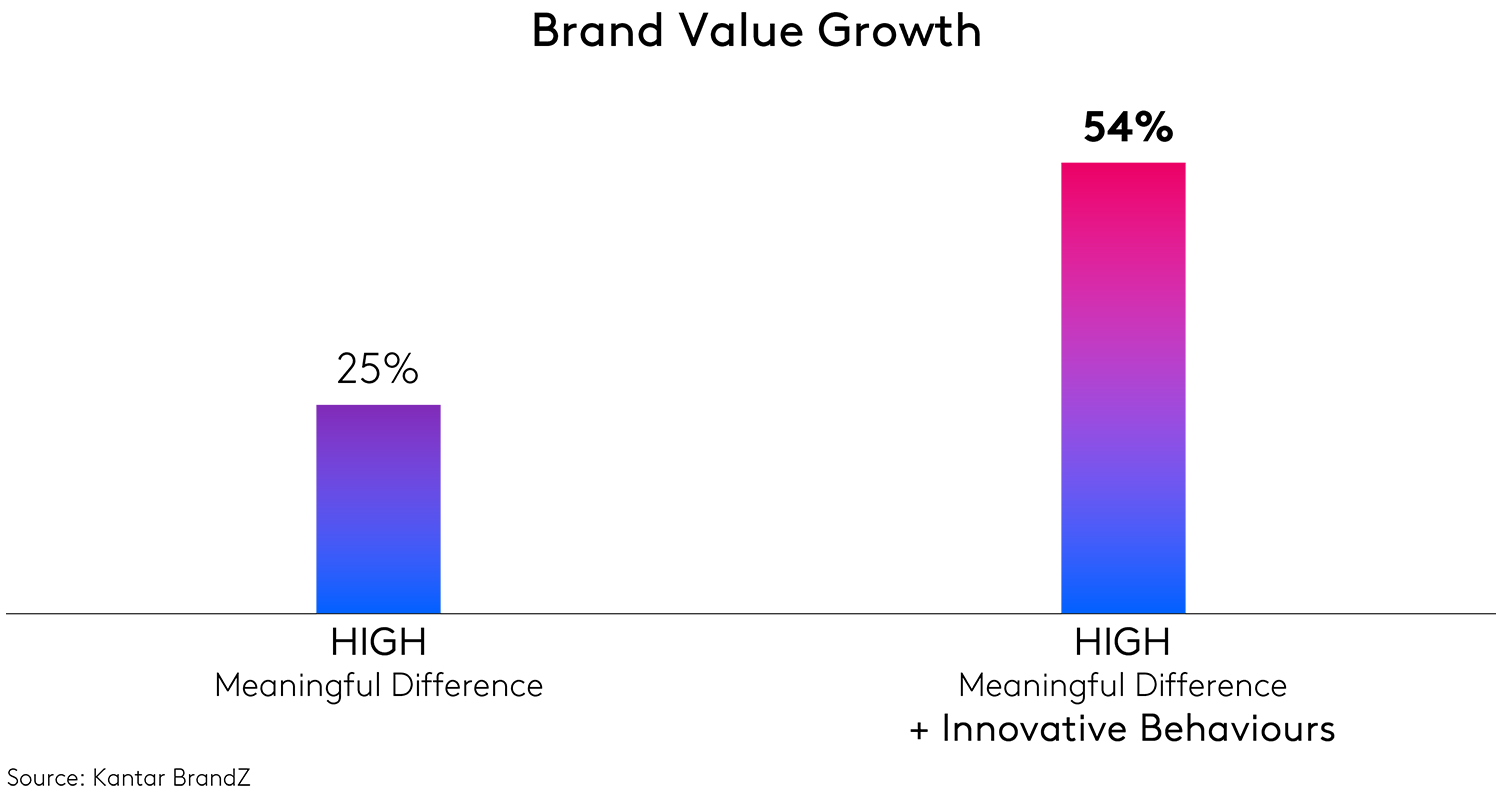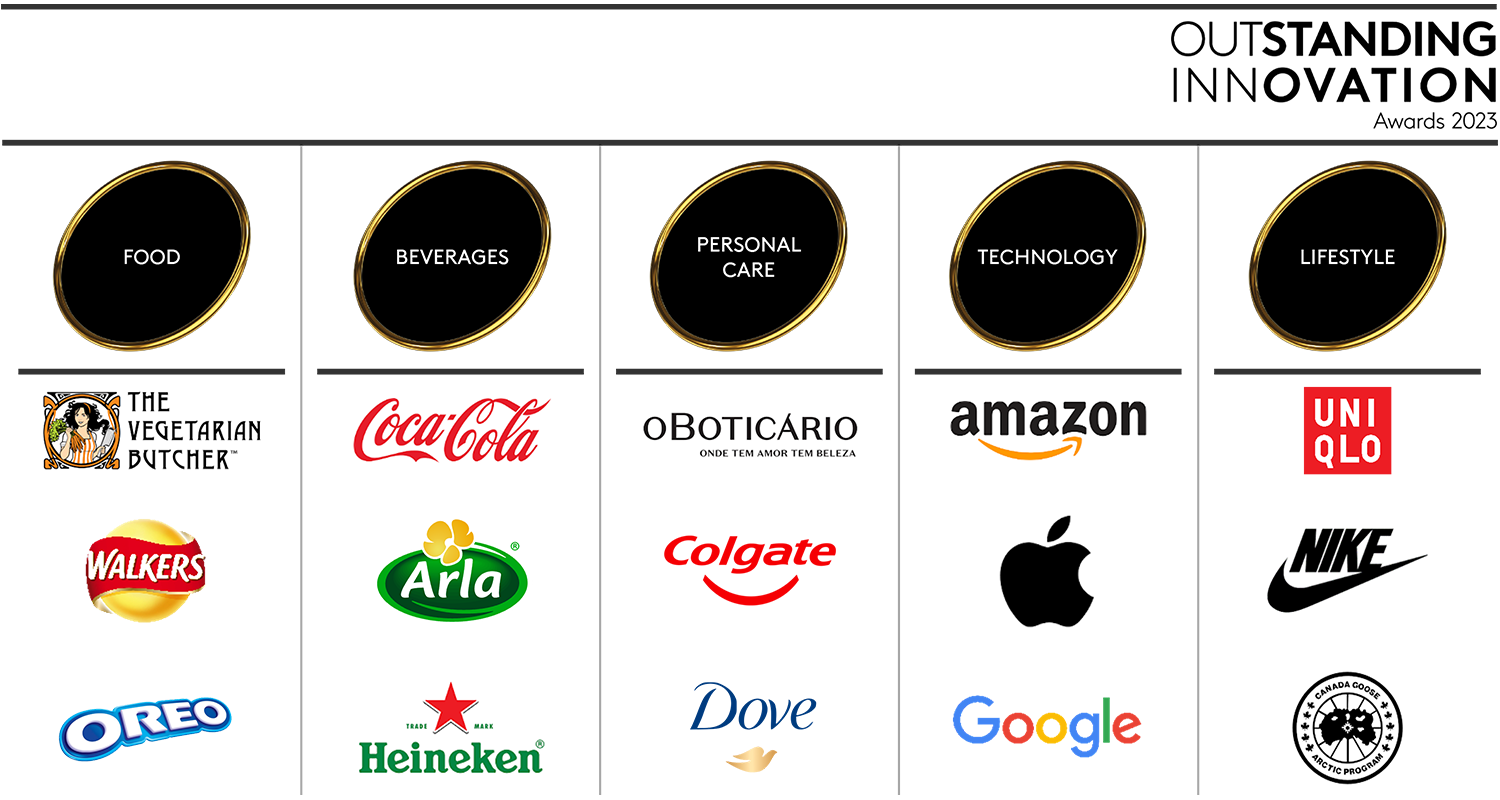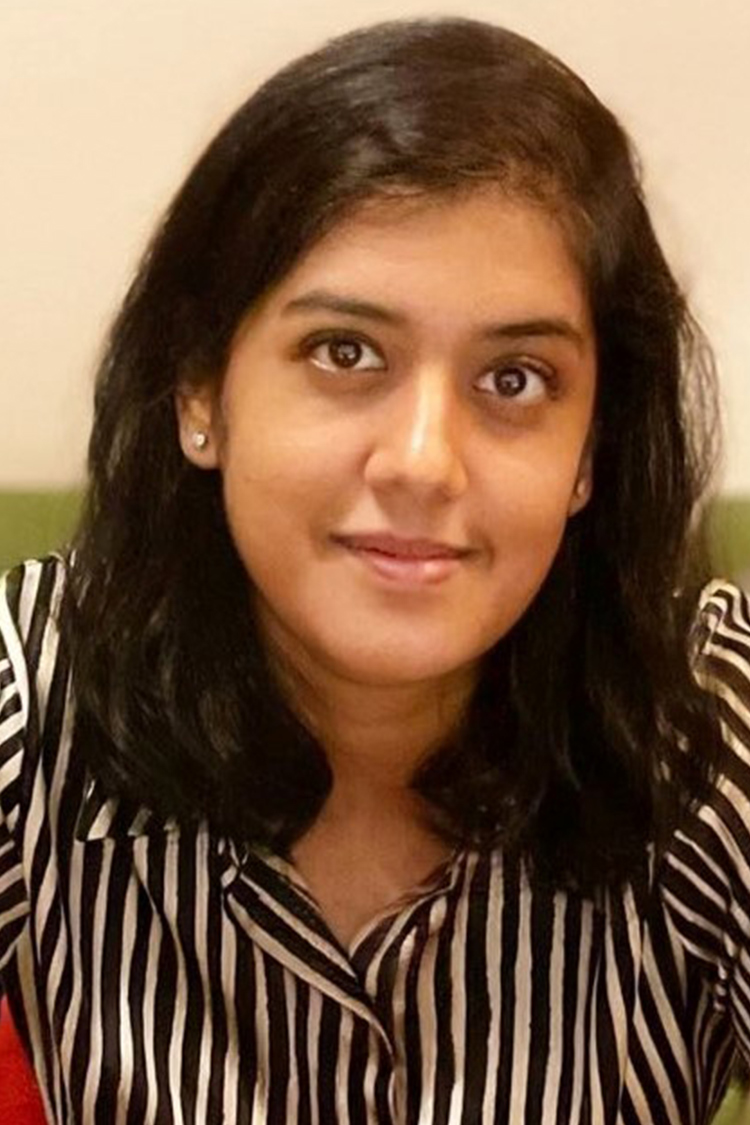How can brands stand out and innovate in inflationary times? How can innovations be meaningfully different in a crowded marketplace? And what is the secret to successful innovation?
To address these innovation challenges and many more, we mined multiple Kantar data sources (Kantar BrandZ, Brand Footprint and Dx Analytics) to identify the brands perceived to be the most innovative brands worldwide – in the eyes of consumers.
Kantar's BrandZ shows that among the Top 100 Most Valuable Global Brands, innovative brands grew at over twice the rate of other brands and that the strongest brands are meaningful, different and salient. Further, it is being different that really makes the difference. Meaningfully different brands grow 25% faster than other brands, and brands that are both meaningful and are perceived to be innovative (shaking things up and/or creating well-designed products) grow 54% faster than other brands.
Brands that are meaningfully different AND innovative grow faster

So, we identified the top-performing brands that are both meaningfully different and innovative. Download our free guide or watch the on-demand webinar to find out more about our winners and what makes them great. Huge congratulations to all our winners!
Top brands use innovation as a lever for growth

Five lessons learned from successful innovators
All of our winners have a track record of using innovation to drive sustained growth. And we learned a lot from analyzing the data for our winners and interviews with the winning brands. These are five common themes we observed that have helped our winners achieve growth through meaningfully different innovation.
1. Embrace a consumer-first mindset
A revolutionary technical advance in materials, functionality or design may offer potential for innovation, but unless that innovation solves a real consumer tension it is unlikely to be successful. This is even more true in challenging times when people’s needs are evolving. A consumer-first mindset involves identifying tensions and blind spots in a specific usage context.
It was clear when talking to our winners that they were looking for this human tension, beyond just whitespaces to focusing on blind spots. They also thought about the factors that influenced choice and designed their innovations to address these. So, check-in with your target audience at critical stages throughout the innovation journey.
“I think sometimes people tend to use the word innovation to refer to product, packaging, and formula. I think the way we see it is looking at how can we create a different set of experiences for people to interact with Coke. For us, the first thing is to really start with people first and how they experience Coke.”
- Selman Careaga, President, Global Coca-Cola Category
2. Be fit for your brand
From consumer-centricity to brand-centricity. Our winning brands were all clear about their brand foundations and had a clear purpose. They built on this clear understanding to help them ensure their innovations are fit for their brand, getting the balance right between protecting the core and looking for incremental growth. Always looking for new ways to be meaningful and different. To do this you need to check your innovations support your brand purpose and the broader portfolio, and look beyond short-term sales to understanding the long-term impact of your innovation on brand equity and growth.
“We have built our purpose into a growth driver. It requires a lot of business modelling and learning - ensuring you do purpose in a commercial way, never loosing track of the business impact but also in a very authentic way, delivering positive change in society.
We got to a point where we really finessed the model and showed that Dove creates strong social impact which in turns creates goodwill with consumers. Purpose simply becomes a considerable accelerator of our growth..”
- Alessandro Manfredi, CMO Dove, Unilever
3. Learn, test and learn
Our winners are on a continuous innovation journey and are willing to learn from their mistakes. They break from the traditional stage-gate thinking to focus on testing assumptions, looking at the unknowns and putting more energy upfront to get to more meaningfully different opportunity spaces. They also spent energy on how they executed and how they understood the performance of their innovations in market.
Shifts in underlying demand caused by the pandemic have yet to play out, but innovators can’t wait for that to happen. They must anticipate the future and continue to test their critical assumptions and sense-check their progress. So learn, test and learn.
"Be willing to try and fail"
President, Global Coca-Cola Category, Selman Careaga says he is proud Coke has a culture where they are willing to try stuff. Selman explained that his teams had found success by giving them full decision rights and empowering them with a sense of urgency.
"You can talk about ideas forever and ever, and then then don't launch them... that’s why I think that the sense of urgency, it's very important."
4. Better for the planet, better for you
Kantar’s Sustainability Sector Index 2022 (SSI) reports that 79% of people want to buy environmentally sustainable products, but a similar proportion believe that it is the responsibility of companies to make sure their sustainable products are affordable. This presents a big challenge for many brands, but the evidence suggests the payoff is worth it. Brands rating highly on sustainability in BrandZ 2022 grew their brand value by 31% over the prior year, outpacing the average for the Top 100 Most Valuable brands. While all our winners acknowledge the need to develop more sustainable products, here we call out The Vegetarian Butcher as a brand committed to a more sustainable future.
Many of our winners put sustainability at the heart of their thinking.
“The footprint of plant-based is sustainable, but every day we work on being more and more and more sustainable.”
- Karlijn Ris, Global Marketing Director, The Vegetarian Butcher
5. Shape the future
The first step in future-proofing your innovation strategy is to step outside the boundaries of what exists now and anticipate what the future might bring. Innovation is a driving force that not just shapes a brand, but also the future of the category and market. These innovative brands, as market leaders with an innovation track record, have continued to safeguard and grow the entire category.
Technology companies are often at the forefront of shaping the future – but it applies to all brands, big or small in any category. Future-shaping is about systematically bringing in holistic outside-in and inside-out thinking lenses to address long-standing and evolving human tensions.
“At the heart of what Oreo does differently is to not blindly follow trends, but start from the brand and consumer, and then exploring ways to bring the playfulness spirit together with these trends -maybe tapping into a new occasion to stretch the brand in the right direction.”
- Eugenia Zalis, Global Head of Marketing and Brand, OREO
What next?
Our winners demonstrate that for innovation to drive growth it must combine a clear strategic business intent with solving a real consumer tension. It must be a win-win for the brand and its consumers. To do this requires a learning mindset and a future-focused perspective designing for the planet and for people. And the evidence shows that if you get it right it benefits long-term brand building and growth as well as shorter-term sales – and hopefully the planet too.
Find out more about our Outstanding Innovation Awards and have a look at how quickly you can get quality consumer insight at different stages of your innovation journey via Kantar Marketplace.


